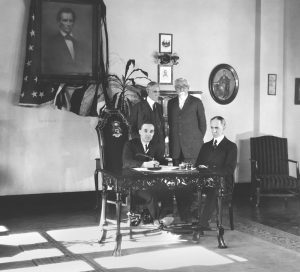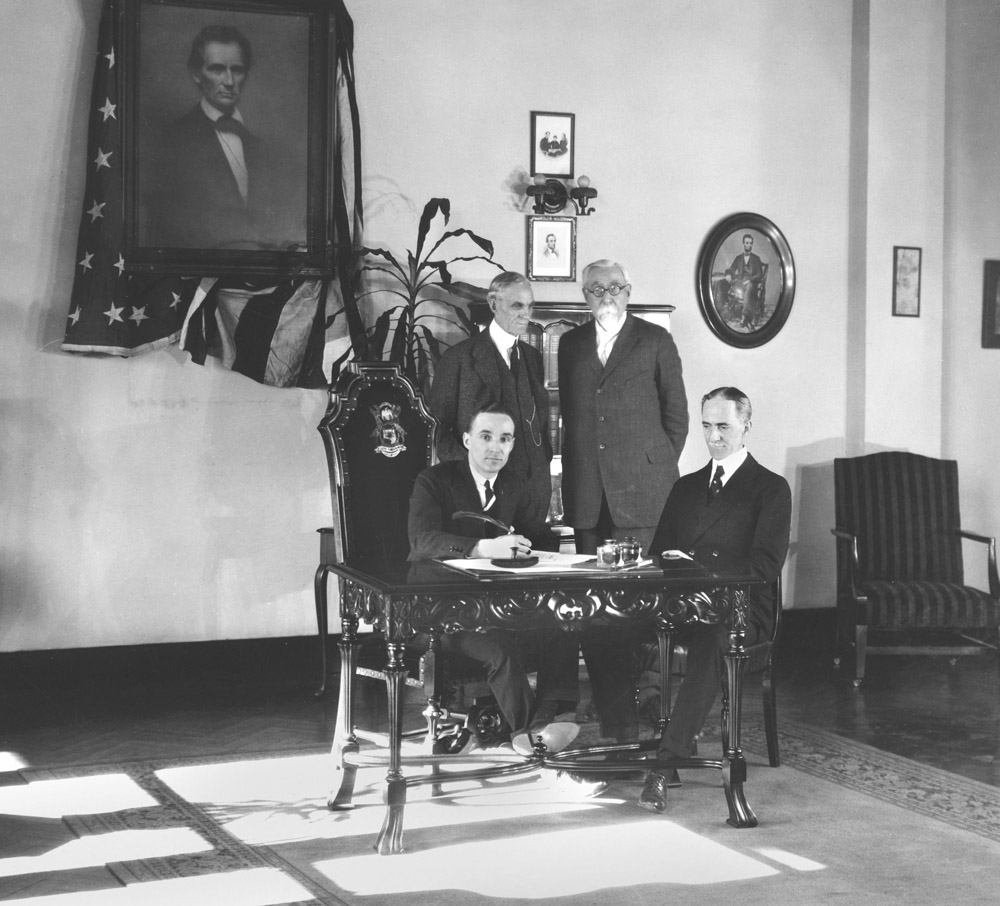
THE LEGEND BEGINS
The turn-of-the-century auto industry was a small, rough and tumble business ideal for tough, visionary entrepreneurs. It was a time when the paths to fortune and failure of many famous names crossed, including the paths of two brilliant pioneers named Henry.
Henry Ford, of course, founded the Ford Motor Company in 1903, with the vision of building low cost, reliable transportation for the masses. His dream revolutionized the world.
A contemporary of Ford, Henry Leland was one of Detroit’s top engineers with a reputation for meticulous and uncompromising standards in quality and performance. Many famous automotive nameplates of the day were powered by Leland engines and transmissions.
Leland also played an instrumental role in a number of industry firsts, including refining the concept of interchangeable parts, the electric self-starter, and the first American-made 90 degree V-8 engine.
The Ford Motor Company wasn’t Henry Ford’s first attempt at making a business of building cars. He built his first car in 1896, and sold it for $200. In 1899, Ford joined the newly-formed Detroit Automobile Company, signing over his patents in return for the title of superintendent. While there, Ford became enamored with racing as a means of promoting the fledgling company. When he won a two car race in 1901, the DAC directors were so pleased, they reorganized the firm into the Henry Ford Company.
However, Ford spent much of his time and energy on his racing efforts. When a new car launch fell behind schedule, the displeased directors called in Henry Leland for advice and counsel. This maneuver infuriated Ford, who left to form the Ford Motor Company where, with the 1908 Model T, he rewrote automotive history. In another ironic twist of history, the Detroit Automobile Company, under Leland’s direction was renamed the Cadillac Motor Company. In 1908, Cadillac would be absorbed by General Motors, in later years becoming a direct competitor to Lincoln.
The Lincoln Motor Company was born in 1917 in a dispute between Leland and GM boss Will C. Durant. Durant vetoed Leland’s proposal that Cadillac produce Liberty aircraft engines for the war effort.
After leaving GM and Cadillac, Leland won a U.S. government contract to supply allied armed forces with Liberty engines, which became famous for their durability and performance. The new company was named after the senior Leland’s idol, Abraham Lincoln.
During the first world war, Leland’s Lincoln Motor Company set records for both daily and monthly production of aircraft engines.
After the war, the Lelands converted their factory to produce premium automobiles. They pledged that their new Lincoln would be “a better, a finer, and a more enduring motor car than had been previously built.” To back their pledge, they invested nearly $6-million in new manufacturing equipment capable of delivering a level of precision never before seen in the automotive industry.
In 1920, the first Lincoln motor car rolled out of the plant on Detroit’s west-side, powered by a smooth-running 60-degree V-8 engine and built according to Leland’s famous standards of quality and craftsmanship. Early enthusiasm and support for the Lelands’ new venture prompted ambitious sales goals – 6000 Lincolns for 1920 and 14,000 the succeeding year.
Unfortunately, low demand and material shortages hampered first-year production and sales, and the fledgling Lincoln Motor Company was driven into financial crisis. After only fifteen months of production, and only 3400 cars, the company fell into receivership.
In February 1922 the Ford Motor Company successfully bid $8 million to buy the assets of the struggling Lincoln Motor Company. Henry Ford told reporters, “We have built more cars than anyone else and now we are going to build a better car than anyone else.”
SETTING A NEW STANDARD
Edsel Ford, Henry’s 28-year-old son and president of Ford Motor Company, took over the helm of the new Lincoln Division. His refined sense of style, coupled with Ford Motor Company’s manufacturing expertise, blended perfectly with Lincoln’s high craftsmanship standards, setting the blueprint for Lincolns of the future. Within a year, Lincoln was a profitable business venture.
Requiring only evolutionary mechanical upgrades, Lincoln sales averaged 7000 cars per year through 1930, and the division’s status at the upper end of the fine car market was secure.
The familiar “Lincoln” oval emblem appeared in 1924. The trademark greyhound radiator ornament was added in 1925. Through the late 1920s, ongoing improvements included standard four-wheel brakes, all-welded steel “safety” wheels, elastomer engine mounts, laminated safety-plate glass, and worm-and-roller steering.
The elegant K-Series was introduced in January 1931. Refined styling and improved chassis designs set the stage for what classic car enthusiasts rate as the ultimate Lincoln – the 1932 KB V-12.
The 1920s and ’30s were truly a period of trial and tribulation for the young automotive business. Six of the ten luxury brands that began the decade collapsed under the weight of the Great Depression. Edsel Ford noted of this bleak period, “We did not stop producing luxury cars – people stopped buying them.”
In an effort to attract a more stable base of customers, Lincoln entered the medium-price class in 1936 with the V-12-powered Zephyr that featured high levels of quality and refinement.
With a name borrowed from America’s first streamlined train, the Burlington Zephyr, and a price less than half of any previous Lincoln, the Zephyr was an instant hit, selling nearly 15,000 units in its first year. Two years later, the line was restyled with one of the auto industry’s first horizontal radiator grilles. The New York Museum of Modern Art called the Lincoln Zephyr “the first successfully-designed streamlined car in America.”
Zephyr’s high style set the stage for the Lincoln Continental, universally regarded as one of the most beautiful automobiles ever designed. In 1938, Edsel Ford asked his close associate, corporate styling chief Eugene “Bob” Gregorie, to create “a special little sports car” for Ford’s personal use. Starting with a 1939 Zephyr, Gregorie lowered the chassis by three to four inches, extended the hood and front fenders, and shortened the trunk. The crowning touch, one that would become a Lincoln trademark well into the 1990s, was an exposed spare tire in the rear.
Four months later, a hand-crafted prototype was delivered to Edsel Ford on vacation in Florida. Several of his wealthy friends were quite impressed and placed orders on the spot. Their enthusiasm was soon rewarded by the elegant 1940 Continental, sporting the company’s first column shift and very few minor changes from the original hand-built prototype.
The Continental nomenclature celebrated the younger Ford’s appreciation of European style. The Museum of Modern Art praised the car this way: “The Continental satisfied the requirements of connoisseurs while capturing the imagination of a public less preoccupied with the refinements of automobile design.”
A NEW AGE OF PROSPERITY
Once again, the dawn of a world war marked a major turning point for America’s auto industry. To support the allied effort in World War II, domestic car production ceased as factories were converted to the manufacture of war material.
When the war ended, and the economy finally returned to civilian production, cars once again replaced tanks in America’s factories. For 1949, all-new Lincolns greeted an enthusiastic and prosperous public eager to travel the highways and byways of America in style and comfort.
The flagship Cosmopolitan pioneered a one-piece curved windshield, recessed headlamps, and a radical fastback roofline. A new V-8 engine delivered 152 smooth, reliable horsepower and could be mated to a Hydra-Matic automatic transmission. The 1951 Cosmopolitan was the last Lincoln to offer a manual transmission until, 49 years later, the 2000 LS V-6 with an optional manual gearbox.
The 1952 model year brought another major round of improvements. Fresh styling featured the industry’s first integrated bumper designs. Lincoln’s first overhead-valve V-8 brought more power and significantly improved gas mileage.
Underneath, an innovative ball-joint front suspension provided a major improvement in ride, handling and steering. A new Capri model carried the Lincoln nameplate successfully back into the upper-luxury ranks. Lincolns also scored impressive victories in Carrera Panamericana road races, earning the marque an illustrious reputation in racing.
In 1956, Lincoln created a celebrated successor to the venerated 1940 Continental. The luxury news of the year was the reintroduction of the Continental nameplate as a “Mark II” – an instant classic in its own right.
The Continental Mark II incorporated hand-built engines and bodywork and luxurious interior trim. The classic long hood, short deck proportions and the prominent spare tire theme of the original were updated with modern grace.
Innovations included a low-fuel warning light and front shock absorbers that changed damping characteristics to suit different driving conditions. Strict quality standards were established for paint, upholstery, and chrome plating. The sale of 2556 Mark IIs wearing a price tag just under $10,000, versus $4119 for a Lincoln Capri Coupé, added luster to Lincoln’s prestige.
1961 marked another major design breakthrough with the freshened Continental, which featured formal body surfaces, curved window glass, and a roof with aggressive tumblehome. The new Continental artfully combined a roomy interior with significantly smaller exterior dimensions. The look wore well throughout the ’60s, earning Lincoln a significant 430,000 sales over nine model years. In fact, research showed that owners loved their Continentals so much they were reluctant to trade for a new one.
For 1968, Lincoln’s Roman-numeral counter was reset with the Continental Mark III, and the personal luxury segment was updated in striking fashion. The new Mark sported an impressive sweeping hood, a prominent vertical chrome grille, hide-away headlamps, a formal roofline, and the trademark spare tire design neatly executed in the decklid.
The Town Car nameplate was introduced as the Lincoln flagship in 1981 and a significantly smaller and lighter four-door-only Continental was introduced in 1982. The 1984 Mark VII reinvigorated Lincoln’s performance heritage with aerodynamic exterior design, electronically controlled air suspension, all-disc brakes, rack-and-pinion steering, and a fuel-injected 5.0-liter V-8 engine. For 1988, Continental was redesigned to front-wheel-drive and V-6-only power.
The 1990s ushered in a long list of technological innovations in the Lincoln line-up. Continuous improvements for the Town Car included dual airbags in 1990, an advanced 4.6-liter SOHC V-8 engine in 1991, and major chassis refinements in 1998. The new-for-1993 Mark VIII was the most sophisticated Lincoln in history with its DOHC 32-valve V-8, fully-independent air suspension, and ABS-equipped four-wheel disc brakes.
In 1995, Continental received 32-valve V-8 power, semi-active shock absorbers and all-speed traction control in 1997, and major interior and exterior design upgrades in 1998.
Also in 1998, Lincoln entered a new era of luxury motoring with the introduction of the all-new Navigator sport utility vehicle. The Navigator was an instant hit with customers seeking the ultimate in style, comfort and versatility.


You must be logged in to post a comment.